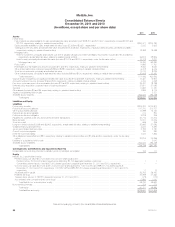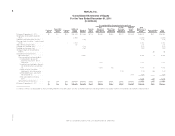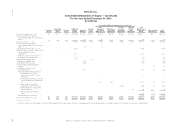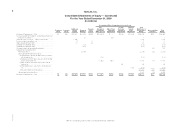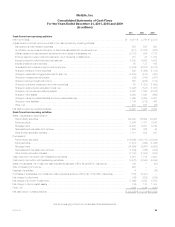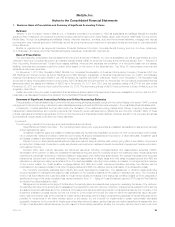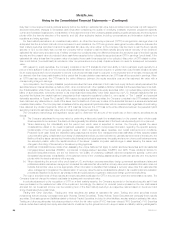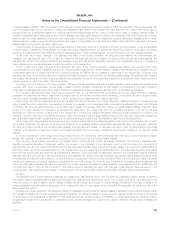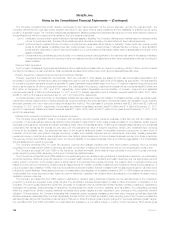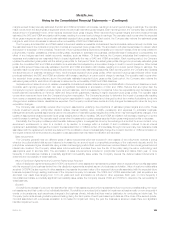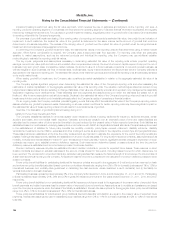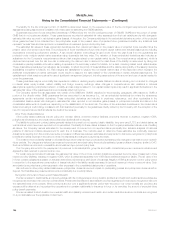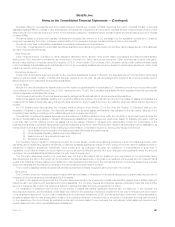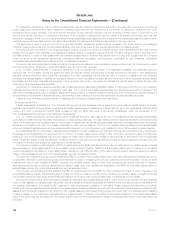MetLife 2011 Annual Report Download - page 102
Download and view the complete annual report
Please find page 102 of the 2011 MetLife annual report below. You can navigate through the pages in the report by either clicking on the pages listed below, or by using the keyword search tool below to find specific information within the annual report.MetLife, Inc.
Notes to the Consolidated Financial Statements — (Continued)
ongoing basis. The monitoring process focuses on higher risk loans, which include those that are classified as restructured, potentially
delinquent, delinquent or in foreclosure, as well as loans with higher loan-to-value ratios and lower debt service coverage ratios. The
monitoring process for agricultural loans is generally similar, with a focus on higher risk loans, including reviews on a geographic and
property-type basis. Higher risk commercial and agricultural loans are reviewed individually on an ongoing basis for potential credit loss and
specific valuation allowances are established using the methodology described above for all loan portfolio segments. Quarterly, the remaining
loans are reviewed on a pool basis by aggregating groups of loans that have similar risk characteristics for potential credit loss, and
non-specific valuation allowances are established as described above using inputs that are unique to each segment of the loan portfolio.
For commercial loans, the Company’s primary credit quality indicator is the debt service coverage ratio, which compares a property’s net
operating income to amounts needed to service the principal and interest due under the loan. Generally, the lower the debt service coverage
ratio, the higher the risk of experiencing a credit loss. The Company also reviews the loan-to-value ratio of its commercial loan portfolio.
Loan-to-value ratios compare the unpaid principal balance of the loan to the estimated fair value of the underlying collateral. A loan-to-value
ratio greater than 100% indicates that the loan’s unpaid principal balance is greater than the collateral value. A loan-to-value ratio of less than
100% indicates an excess of collateral value over the loan’s unpaid principal balance. Generally, the higher the loan-to-value ratio, the higher
the risk of experiencing a credit loss. The debt service coverage ratio and loan-to-value ratio, as well as the values utilized in calculating these
ratios, are updated annually, on a rolling basis, with a portion of the loan portfolio updated each quarter.
For agricultural loans, the Company’s primary credit quality indicator is the loan-to-value ratio. The values utilized in calculating this ratio are
developed in connection with the ongoing review of the agricultural loan portfolio and are routinely updated.
Residential Mortgage Loans — The Company’s residential loan portfolio is comprised primarily of closed end, amortizing residential loans
and home equity lines of credit and it does not hold any optional adjustable rate mortgages, sub-prime, or low teaser rate loans.
In contrast to the commercial and agricultural loan portfolios, residential loans are smaller-balance homogeneous loans that are collectively
evaluated for impairment. Non-specific valuation allowances are established using the evaluation framework described above for pools of
loans with similar risk characteristics from inputs that are unique to the residential segment of the loan portfolio. Loan specific valuation
allowances are only established on residential loans when they have been restructured and are established using the methodology described
above for all loan portfolio segments.
For residential loans, the Company’s primary credit quality indicator is whether the loan is performing or non-performing. The Company
generally defines non-performing residential loans as those that are 90 or more days past due and/or in non-accrual status. The
determination of performing or non-performing status is assessed monthly. Generally, non-performing residential loans have a higher risk of
experiencing a credit loss.
Mortgage Loans Modified in a Troubled Debt Restructuring. For a small portion of the portfolio, classified as troubled debt restructurings,
concessions are granted related to the borrowers’ financial difficulties. Generally, the types of concessions include: reduction of the contractual
interest rate, extension of the maturity date at an interest rate lower than current market interest rates and/or a reduction of accrued interest. The
amount, timing and extent of the concession granted is considered in determining any impairment or changes in the specific valuation allowance
recorded in connection with the troubled debt restructuring. Through the continuous portfolio monitoring process, a specific valuation allowance
may have been recorded prior to the quarter when the mortgage loan is modified in a troubled debt restructuring. Accordingly, the carrying value
(after specific valuation allowance) before and after modification through a troubled debt restructuring may not change significantly, or may
increase if the expected recovery is higher than the pre-modification recovery assessment.
Mortgage Loans — Mortgage Loans Held-For-Sale. This caption includes three categories of mortgage loans:
Residential mortgage loans – held-for-sale. Forward and reverse residential mortgage loans originated with the intent to sell, for which
the FVO was elected, are stated at estimated fair value. Subsequent changes in estimated fair value are recognized in other revenues.
Mortgage loans – held-for-sale – lower of amortized cost or estimated fair value. Mortgage loans that were previously designated as
held-for-investment, but now are designated as held-for-sale, are stated at the lower of amortized cost or estimated fair value. At the time of
transfer to held-for-sale status, such mortgage loans are recorded at the lower of amortized cost or estimated fair value, or for collateral
dependent loans, estimated fair value less expected disposition costs, with any loss recognized in net investment gains (losses).
Securitized reverse residential mortgage loans. Reverse residential mortgage loans originated with the intent to sell which have been
sold into Government National Mortgage Association (“GNMA”) securitizations, for which the FVO was elected, are stated at estimated fair
value. Prior to December 31, 2011, consistent with historical industry practice, these standard form loans were de-recognized from the
balance sheet upon the GNMA securitization. However, after an industry led review of the GNMA securitization program, the Company has
determined that these securitized reverse residential mortgage loans do not qualify for de-recognition. Therefore, as of December 31, 2011
the Company recorded $7.7 billion of reverse mortgage loans, included within mortgage loans held-for-sale. The FVO was also elected for
the $7.6 billion corresponding liability, included within other liabilities. Subsequent changes in estimated fair value of both the asset and
liability are recognized in other revenues. The Company’s economic exposure is generally limited to its servicing rights. Prior year amounts
have not been included in the financial statements as these amounts were not material to such financial statements.
Policy Loans. Policy loans are stated at unpaid principal balances. Interest income on such loans is recorded as earned in net investment
income using the contractually agreed upon interest rate. Generally, interest is capitalized on the policy’s anniversary date. Valuation allowances
are not established for policy loans, as these loans are fully collateralized by the cash surrender value of the underlying insurance policies. Any
unpaid principal or interest on the loan is deducted from the cash surrender value or the death benefit prior to settlement of the policy.
Real Estate. Real estate held-for-investment, including related improvements, is stated at cost less accumulated depreciation. Depreciation
is provided on a straight-line basis over the estimated useful life of the asset (typically 20 to 55 years). Rental income is recognized on a straight-
line basis over the term of the respective leases. The Company classifies a property as held-for-sale if it commits to a plan to sell a property
within one year and actively markets the property in its current condition for a price that is reasonable in comparison to its estimated fair value.
The Company classifies the results of operations and the gain or loss on sale of a property that either has been disposed of or classified as
held-for-sale as discontinued operations, if the ongoing operations of the property will be eliminated from the ongoing operations of the Company
and if the Company will not have any significant continuing involvement in the operations of the property after the sale. Real estate held-for-sale is
98 MetLife, Inc.


